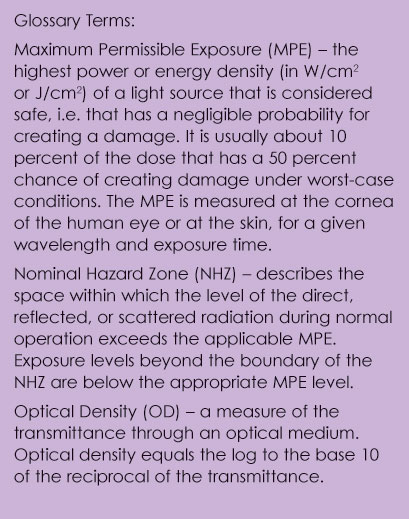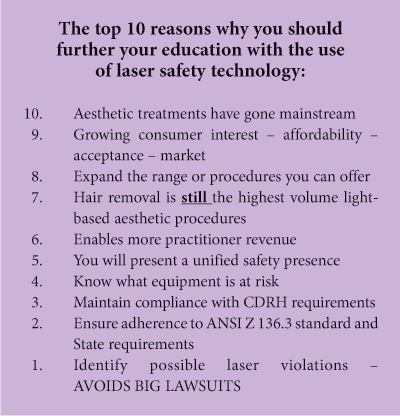When I go to the doctor’s office, it is important for me to see their credentials on the wall of their office or in the hallway. Credentials also set you apart from the rest; it inspires confidence in your clients and colleagues that you have taken that extra step in training.
- As a client, should I be concerned with your academic competency?
- Would I know if you chose the right training course for the procedure that I am requesting?
- What was the duration of the course that you took?
- Was it an academic State approved credentialed physician supervised hands-on training program?
- Was your course over a weekend in a hotel room?
- Were there pertinent laser safety issues that will affect you the user and me the patient taught in your curriculum?
- How often do you practice this procedure?
You and I know these questions would not be what the average person would ask of you, or would they? Clients today are savvier with laser procedures than ever before because of laser articles in magazines and various laser advertising. They are aware that you have taken some type of laser course, but?
Mom and Pop laser store fronts, some beauty salons, and non-medical spas are popping up everywhere with low pricing to attract clients. They may have attended some type of short course that teaches one, sees one, and they do one. In some cases, they are here today and gone tomorrow, accidents occurring, and the storefront laser spa is nowhere to be found.
Laser safety is an equally important part of your curriculum for laser aesthetic training. It is the backbone of your program. To insure proper guidelines for the safe use of lasers in your facility, it is recommended that your facility purchase an "American National Standard for Safe Use of Lasers in Health Care Facilities ANSI Z136.3 2005".
One should have been provided to you as part of your laser aesthetic and safety training program. This standard is used as a guide to incorporate laser use in a non-hospital facility such as out patient facilities, individual offices, and non-medical locations.
Laser Safety Officer
The next item on your agenda is to appoint a Laser Safety Officer (LSO). What is an LSO and why do you need one if you are outside of hospital or surgery center? What are the advantages and disadvantages of being an LSO? The LSO is the person who is appointed by the Health Care Facility (HCF) who will be responsible for the laser safety program. As quoted from the ANSI Z-136.3 Standard,
"The LSO is authorized by the HCF administration and is responsible for monitoring and overseeing the controls of laser hazards. The LSO shall effect the knowledgeable evaluation and control of laser hazards by utilizing, when necessary the most appropriate clinical and technical support staff and other resources."
Without proper training, how could the LSO properly effect or evaluate any laser hazards? What makes a good LSO? There is no experience required, just the desire and willingness to be trained in laser safety. Is it the ability to get along with workers about safety or have a passion for protecting user, patient, and in keeping facility in check? Develop excellent listening skills, knowledge of risks, with perseverance, persistence, and ability to overcome resistance. Have a good network system and a flexible approach for solving problems and belief that everyone wants to be safe.
Some LSO challenges and opportunities are getting workers to listen; you're the new kid on the block exploding with idealistic ways in putting your facility out of harms way and you want everyone to be safe. Your expertise comes into play by training the staff in laser safety. Without proper laser safety training, the staff will have low expectations for safety contribution. The unsaid attitude: "It is not my job; it is your job as LSO." In some facilities, older workers are slowing down and younger workers running around. It is very important in health care facilities to have teamwork since it allows one to criticize someone else when things go wrong.

A laser safety program involves many approaches; we have already discussed the purchasing of the ANSI Z-136.3 Standard, the appointing of an LSO, now on to some specifics. There are Federal, State, Local Regulations, and Non-Governmental agencies that are associated with lasers on different levels. The FDA and Center for Devices and Radiological Health (CDRH) are Federal standards. OSHA is a governmental regulatory body used with medical lasers; National Fire Protection Association-NEC (NFPA) and STATE are state and local; and the non-governmental are The Joint Commission on Accreditation of Healthcare Organizations (JCAHO), ANSI Z-136.3 Standard and the American Society for Laser Medicine and Surgery (ASLMS).
Laser classifications are as follows:
- Class l – No known biological hazard
- Class 2 – No known biological hazard unless viewed for long periods of time in unaided eye
- Class 1M and 2M – pose the same risk as Classes 1 and 2
- Class 3 – May be hazardous for direct exposure to specular reflections
- Class 4 – Biological hazard to eye, skin, and fire hazards from direct or specular reflections
As a Laser Safety Officer, some major areas of LSO responsibility in implementing the ANSI Z-136.3
Standard are:
- Establishing control measures such as Nominal Hazard Zone (NHZ) analysis, beam path in laser suite, selecting eyewear, area posting signs, non-beam controls, temporary laser area, entryway controls, equipment modification, window coverings, and protective equipment.
- Effect hazard analysis, Maximum Permissible Exposure (MPE) determination; confirm hazard class, Nominal Hazard Zone (NHZ) and Optical Density (OD) of eyewear, facility/equipment approval, facility audits, and non–beam evaluations.
- Administrative and management requirements, laser committee, management support, Standard Operating Procedures, SOP's record keeping, laser logs, service, safety audits, education and other reports, training programs, meetings and conferences, publications, medical surveillance, state rules, and standards.
Other Laser Safety Officer responsibilities are:
- Administrative controls such as authorization for laser use, "SOP's", maintenance, service and purchases. Assure that maintenance and service is done by trained persons following ANSI criteria. Approve all SOP's.
- Equipment controls, delivery shall not permit exposure>MPE, FDA labels acceptable for ANSI do not cover up labels, laser key, LSO checks after service for greater hazards, LSO determines if additional controls are needed following laser modifications, quality control/safety audits by LSO, posting of warning signs Class 3B and Class 4.
- Maintenance, service and procedural controls, significant hazards during alignment, electrical and eye hazards, LSO approves SOP's for alignment, service personnel comply with controls, education and training required.
- Standard operating procedures required for all Class 4 lasers, education and training required and documented for all personnel working with and around the laser.
Laser Safety
Laser safety should be the number one priority when a laser procedure is to be performed.
There are about 500,000 healthcare workers involved with lasers more today with new technology and applications. Because of the rapid growth of new laser procedures, some health care laser facilities are being "down-sized" because of wrong purchases, poor marketing, not understanding the technology, lack of training, and the big reason, the user does not understand the lasers capability.
The number of reported accidents worldwide are about 600 over 40 years. You are thinking to yourself that's not very many accidents, however, keep in mind this represents only reported accidents. Reported accidents are mainly eye/skin sites (beam) and fires (non-beam). Beam accidents directly related to the magnitude of laser power, which is directly related to laser class. Many non–beam situations are related to the magnitude of the radiance (at point of surface).

There still are concerns over:
- dark YAG glasses
- credentialing issues
- who should be the LSO
- need for eye exams
- laser use in medical laser spas
- maintenance contracts
- laser smoke
- OD determinations
- training staff
- mobile lasers
- who can operate the laser
Now with the impact of insurance companies requesting laser safety training programs to be presented to staff members of the laser spa who will be operating the laser before the spa can be insured.
Medical spas versus the ANSI standard:
- Medical spas need direction/supervision. The ANSI standard says you need a Laser Safety Officer/Laser Safety Committee.
- The medical spa requires staffing; the ANSI standard does not cover staffing.
- Medical spas require policies/procedures; the ANSI standard requires SOP's.
- Medical spa requires equipment. The ANSI standard does not give advice on which laser to purchase or which laser is better suited for your practice, only safe use for the laser.
- The medical spa requires safety, whereas the ANSI standard requires safety, laser related.
- The medical spa requires records/and reports. The ANSI standard requires some which are laser related.
- The medical spa requires continuing education; the ANSI standard requires laser related education.
For a successful laser program, the medical spa should have a solid foundation in "laser safety", proper patient selection, management of complications, and the right laser procedure with the right laser. The ANSI Z 136.3 standard states in section 1.4,
In the non-hospital environment:
- It is the responsibility of the user in the non-hospital environment to be aware of the requirements for safe laser use.
- The user shall be responsible for all the requirements in the ANSI standard.
- The user shall assume administrative responsibilities.
- The user shall be trained in laser safety and know local and Federal regulations.
- The user is responsible for among others, physical facility, signs, eyewear, safety measures for patient and others.
- The user is responsible for laser audits.
- The user is responsible for overseeing maintenance and other practices required for safe operation.

In closing, as was mentioned in the beginning of the article, Academic Professional Credentials set you apart from the rest. It inspires confidence in your clients and colleagues. Academic competency in choosing the right aesthetic medical laser training safety course, State approved, physician supervised hands-on, and most importantly understanding pertinent laser safety issues that will affect you, the user.
This article is just the tip of the iceberg; there is so much information available for the LSO and laser facility: having the right tools, attending a laser safety training seminar, receiving policy and procedures and SOP's in hard copy and disk, safety audit forms, ANSI standard, laser manual for the job, being prepared for any situation, and proudly displaying your academic accomplishment in "Laser Safety Training."
Reference:
ANSI Z136.3 - 2005
American National Standard
For the Safe Use of Lasers in Health Care Facilities
Betty Minor, BS, RN is President of Laser Resource, Inc., Aurora, Colorado since 1986 actively consults and teaches laser safety programs, facility safety audits and overall laser safety development across the country. She was the Operating Room Director of Surgical Services; Director of Education east coast based Laser Company. She is a Sitting Member of the ANSI Z136.3 Safety Committee. She was instrumental in the development of the Medical Laser Safety seminar, which is recognized throughout the country as the most informative and practical for any health care laser facility. For more information, please contact her via e-mail at This email address is being protected from spambots. You need JavaScript enabled to view it.
Want to read more?
Subscribe to one of our monthly plans to continue reading this article.